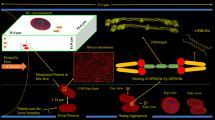Abstract
A theoretical model for the deposition and detachment of protein and platelets on biomaterial surfaces is presented here. This work is an extension of themodel previously reported (12). Two mechanisms of protein and platelet removal are assumed: (1) A characteristic time elapses before adsorbed protein detaches from the surface, carrying away platelets and protein which have deposited on top of it; and (2) thrombi that attain a critical size are subject to hydrodynamic forces which embolize them from the surface. A theoretical distribution of thrombus sizes is assumed. Analysis of the effects of varying model parameters on predicted protein and platelet deposition reveals that the addition of the embolization process does not change the overall structure of the deposition profiles, but does significantly affect the finer details.
Similar content being viewed by others
References
Beissinger, R.L. and E.F. Leonard. Immunoglobulin sorption and desorption rates on quartz: Evidence for multiple sorbed states.ASAIO J. 3:160–175, 1980.
Brash, J.L. and Q.M. Samak. Dynamics of interactions between human albumin and polyethylene surface.J. Colloid Interface Sci. 65:495–504, 1978.
Butruille, Y.A., E.F. Leonard and R.S. Litwak. Platelet-platelet interactions and non-adhesive encounters on biomaterials.Trans. Am. Soc. Artif. Intern. Organs 21:609–616, 1975.
Christenson, J.T., J. Megerman, K.C. Hanel, G.J. L'Italien, H.W. Strauss and W.M. Abbott. The effect of blood flow rates on platelet deposition in PTFE arterial bypass grafts.Trans. Am. Soc. Artif. Intern. Organs 27:188–191, 1981.
Friedman, L.I. and E.F. Leonard. Platelet adhesion to artificial surfaces: consequences of flow, exposure time, and blood condition and surface nature.Fed. Proc. 30:1641–1646, 1971.
Hahn, G.J., and S.S. Shapiro.Statistical Models in Engineering, New York, Wiley, 1967, pp. 130–134.
Hampton, J.R. and J.R.A. Mitchell, Thrombosis. In:Human Blood Coagulation, Haemostasis and Thrombosis, edited by R. Biggs. Oxford: Blackwell Scientific, 1972, pp. 476–496.
Hanson, S.R., L.A. Harker, B.D. Ratner and A.S. Hoffman. In-vivo evaluation of artificial surfaces with a non-human primate model of arterial thrombosis.J. Lab. Clin. Med. 95:289–304, 1980.
Ihlenfeld, J.V., T.R. Mathis, L.M. Riddle and S.L. Cooper. Measurement of transient thrombus deposition on polymeric materials.Thromb. Res. 14:953–967, 1979.
Kim, S.W. and R.G. Lee. Adsorption of blood proteins onto polymer surfaces.Adv. Chem. Ser. 145:218–229, 1975.
Lelah, M.D., L.K. Lambrecht and S.L. Cooper. A canine ex vivo series shunt for evaluating thrombus deposition on polymer surfaces.J. Biomed. Mater. Res. 18:475–496, 1984.
Marmur, A. and S.L. Cooper. A model for the depositions and detachment of proteins and platelets on biomaterials.J. Colloid Interface Sci. 89:458–465, 1982.
Mustard, J.F. The fate of thrombi. InThrombosis, edited by S. Sherry, K.M. Brinkhous, E. Genton and J.M. Stengle. Washington D.C.: Natl. Acad. Sci., 1969, pp. 496–505.
Pitt, W.G. and S.L. Copper. The effect of shear rate upon protein adsorption on polymer surfaces.Trans. Soc. Biomater. 8:28, 1985.
Richardson, P.D. Effect of blood flow velocity on growth rate of platelet thrombi.Nature 245:103–104, 1973.
Rodvien, R., J. Robinson, R.R. Mitchell, P. Litwak and D.C. Price. A new model for in vivo platelet and thrombus kinetics.Adv. Chem. Ser. 199:25–34, 1982.
Ruckenstein, E., A. Marmur and W.N. Gill. Growth kinetics of platelet thrombi.J. Theor. Biol. 66:147–168, 1977.
Schaffnit, R.S. The effects of surface properties on initial platelet adhesion in vitro, M.S. Thesis, University of Washington, Seattle, 1978.
Soderquist, M.E. and A.G. Walton. Structural changes in proteins adsorbed on polymer surfaces.J. Colloid Interface Sci. 75:386–397, 1980.
Strong, A.B., D.R. Absolom, W. Zingg, O. Hum, C. Ledain and B.E. Thompson. A new flow cell for platelet adhesion studies.Ann. Biomed. Eng. 10:71–82, 1982.
Young, B.R., L.K. Lambrecht, S.L. Cooper and D.F. Mosher. Plasma proteins: Their role in initiating platelet and fibrin deposition on biomaterials.Adv. Chem. Ser. 199:317–350, 1982.
Author information
Authors and Affiliations
Rights and permissions
About this article
Cite this article
Wilson, R.S., Marmur, A. & Cooper, S.L. A model of deposition and embolization of proteins and platelets on biomaterial surfaces. Ann Biomed Eng 14, 383–400 (1986). https://doi.org/10.1007/BF02367410
Issue Date:
DOI: https://doi.org/10.1007/BF02367410




